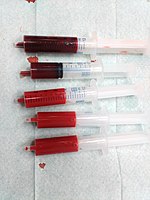
Photo from wikipedia
Background Both capillary and venous blood samples have been interchangeably used for the diagnosis of malaria in Ethiopia. However, Plasmodium parasites are thought to be more concentrated in capillary than… Click to show full abstract
Background Both capillary and venous blood samples have been interchangeably used for the diagnosis of malaria in Ethiopia. However, Plasmodium parasites are thought to be more concentrated in capillary than in venous blood. Hence, selecting a sample source where parasites are more concentrated is indispensable approach in order to maximize the accuracy of blood film microscopy. Therefore, the present study aimed to compare the detection rate and the parasitemia level of Plasmodium species from conventional capillary and venous blood films, and buffy coat preparations. Methods A facility based cross-sectional study was conducted from Feburary to March 2020 among 210 febrile patients attending Hamusite health center, northwest Ethiopia. Capillary and venous blood samples were collected and buffy coat was prepared from each sample. Thin and thick blood films were prepared, stained, and examined microscopically following standard protocol. Data were analysed using Statistical Package for Social Sciences Software version 20 and Med-Calc software version 19.3. Results Capillary blood buffy coat (61/210, 29.0%) had significantly higher detection rate as compared to capillary (48/210, 22.9%) and venous (42/210, 20.0%) blood films ( p < 0.001). However, no significant difference was observed between capillary and venous blood films ( p = 0.070) in detecting Plasmodium species. The highest and the lowest mean asexual stage parasite counts were found in capillary blood buffy coat (4692.88) and venous blood (631.43) films, respectively showing significant variations ( p < 0.001). Mean gametocyte count was also highest in capillary blood buffy coat (3958.44). As compared to capillary blood buffy coat, the sensitivity of venous blood buffy coat, capillary blood film and venous blood film were 73.8, 78.7, 68.9%, respectively. Conclusion Capillary blood buffy coat samples showed the highest sensitivity in detecting and quantitating malaria parasites that its use should be promoted in clinical settings. However, conventional capillary and venous blood films could be used interchangeably.
Journal Title: BMC Infectious Diseases
Year Published: 2021
Link to full text (if available)
Share on Social Media: Sign Up to like & get
recommendations!